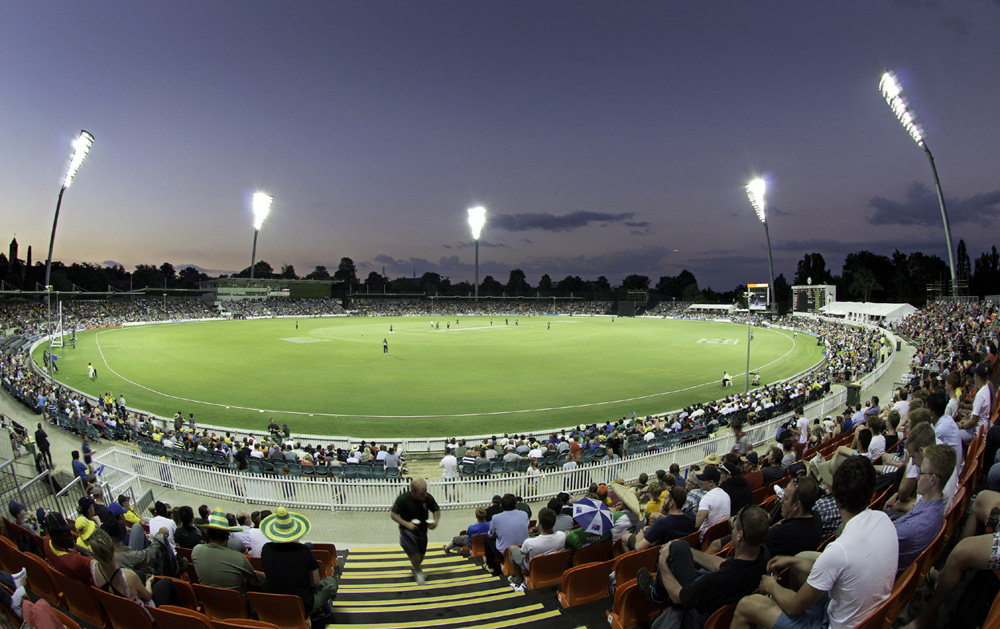UK Firm Puts Australian Capital Cricket Pitch On World Stage
Australian Prime Minister says, “The lights are a tribute to modern Canberra”

As the West Indies launched their bowling attack against Australia last Tuesday night in Canberra, 10,000 miles and an eleven hour time difference away, a team of UK engineers slept peacefully in their beds, knowing that if it wasn’t for them, this game would never have been possible.
The day-night international cricket match, attended by the Australian Prime Minister Julia Gillard and Ministers of the Australian Government was the first in the city’s history, thanks to a new sophisticated and iconic lighting system installed by UK lighting company, Abacus. Beating off competition from around the world and working to tight deadlines, the Nottinghamshire based team of engineers designed, developed and installed an innovative new floodlighting system for the stadium.
In her speech after the game with Australia won, the Australian Prime Minister complimented the floodlights and said ‘The lights are a tribute to modern Canberra’.
As well as being an impressive new addition to the city’s skyline, the lights mean that the ground is now able to attract world-class sporting events of a standard, never before believed possible, bringing welcome investment and tourism to the city in its centenary year. The new lighting levels mean that the stadium will be able to welcome both Australian Rules Football and cricket matches for many years to come.
The shipping of these impressive lighting structures was complex with 180,000kgs of lighting travelling over land and sea to meet the installation deadline ahead of last week’s switch on. The sea freight shipment alone included 20 containers whilst two large custom steel pallets were flown directly via Singapore Airlines airfreight from East Midlands and London Heathrow in the UK to Changhi Airport and then onto to Canberra Airport in Australia.
With an array of stadium lighting projects such as Lords, The Oval, Edgbaston and Trent Bridge, Abacus has used the latest technology to ensure that Manuka’s Oval stadium lighting is now the most sophisticated of any ground in Australia.
564 floodlights are attached to 6 bespoke 45 metre masts with a distinctive headframe. Each mast contains four different types of light – wide, medium, narrow and extra-narrow – which are fanned out to ensure an equal coverage on the playing surface.
Trade and Investment Minister Lord Green said, “This is a multi-million pound contract which has caused a real stir in Australia, highlighted by all the positive media attention it has attracted.
”And it’s a real testament to how far this Nottinghamshire business has come. I understand that 40% of Abacus contracts are won overseas. This sets a great example to other small and medium-sized businesses, not only in the East Midlands, but also around the UK. Once again this shows that on the back of the 2012 Olympics, British commercial sporting expertise is most certainly in demand.”
Ron Maginness, Project Manager of the Manuka project commented, “Unquestionably the design outcome of Manuka is outstanding and sets new standards for sports lighting throughout the world. It is a credit to the fabrication team at Abacus in the UK that the on-site assembly went together like clockwork, and a credit to the on-site team for their dedication to the task and strong work ethic. It has been a privilege to be part of the team and I thank Abacus for their outstanding efforts.”
Andrew Morris-Richardson, Group Managing Director of Abacus Lighting commented, “Abacus is delighted to have developed a completely unique and iconic design for the Manuka Oval, which is not only suitable for cricket matches but also Australian Rules Football. This will have a profoundly positive impact on all future teams competing at Manuka and will enable continued Manuka sporting success.”
CONTACT
Mike Heath
Abacus Lighting Ltd
mheath@abacuslighting.com
www.abacuslighting.com
+44 (0) 1623 511111
Tuesday 5 February 2013 / file under Sports | Engineering | Construction



